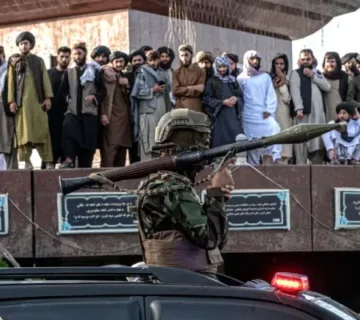75 Years of Occupation in Palestine
Although not many years have passed since the establishment of the State of Israel, in its short lifespan, this government has not only occupied the land of Palestine but has also encroached upon neighboring countries and seized independent territories from some of them. The history of this occupation began in 1948, with the displacement of 700,000 Palestinians and the founding of the state on their land, continuing with attacks on Syria, Jordan, Lebanon, and Egypt. In such a way that in 1949, after warring with these countries, this government agreed to a ceasefire and solidified its control over the new entity on 78 percent of historic Palestine. Once again, the Israeli government attacked Egypt’s Sinai Desert, Syria’s Golan Heights, the West Bank of Palestine, and Gaza in 1967. In 1982, while negotiating withdrawal from Egypt, this government invaded Lebanon and was forced to retreat in 2000.¹ Currently, the Israeli government’s occupation in Palestine, part of Syria, and the Shebaa Farms in southern Lebanon continues.1
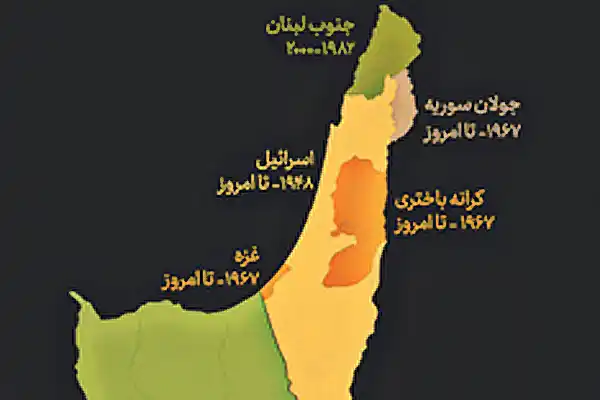
Dividing a United People
One of the key questions about the situation in Palestine is how Israel has managed, throughout all the years since its establishment, to strengthen its apartheid system over Palestine and deny the right to self-determination for this land. In reality, this severe racial oppression against Palestinians has been created through the laws, policies, and practical measures of the Zionist regime in the areas of nationality and territory, resulting in a true example of the “crime of apartheid.” In other words, the Israeli regime has geographically separated the Palestinian people from one another, imposed separate legal and political systems on them, and enforced its apartheid system upon them. The strategic fragmentation of the Palestinian people by Zionists is divided into four parts, as follows:
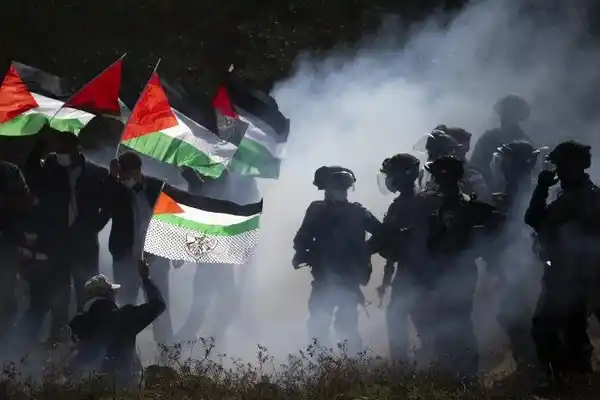
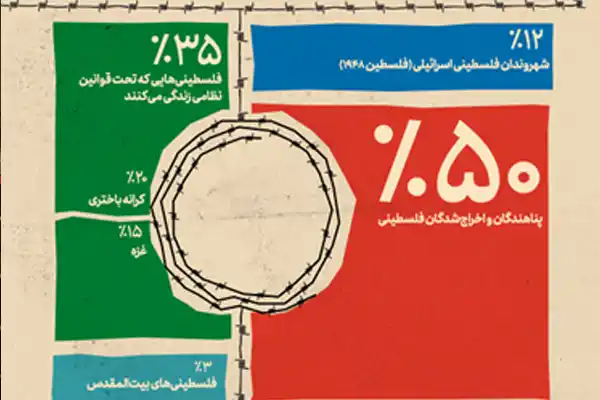

1) 12 percent of Palestinian citizens (from Palestine 1948) are under Israeli citizenship, but it’s an inferior citizenship compared to that granted to Jews.
2) 35 percent of Palestinians live under military laws, and to date, policies and actions such as long-term military occupation, restrictions on entry and exit, the blockade of the Gaza Strip, the 2002 separation wall, severe movement restrictions, and more have been imposed on them.
3) 50 percent of Palestinians are displaced or refugees in other lands, deprived of the right to return to their homes, lands, and country. Of these, 5 million are exiles who were forcibly driven out of Palestine. Additionally, 760,000 Palestinians were internally displaced in Palestine in 1948, coinciding with the establishment of the Zionist state.
4) 3 percent of the Palestinian population resides in Jerusalem, subject to the Zionist regime’s civil law, and in reality, they endure a revocable residency status.
In this way, Palestinians can no longer see each other, form groups, or pursue their collective rights, especially the right to self-determination for their land. Israel has also been able to guarantee, through apartheid laws, policies, and methods, the denial of the right of return for Palestinian refugees, the continuation of forced transfers of Palestinians, the dispossession of Palestinian people, the strengthening of colonialism, and Israeli settlement building. 2
Israel’s Expansion, Palestine’s Shrinkage
Another issue regarding the occupation of Palestine is the Zionist regime’s advancement into this land through various methods. The Zionist regime began expanding its territory in Palestinian soil years before the official establishment of the State of Israel and continued it in subsequent years. In fact, the seizure of Palestinian land by Zionists started in 1918, when the country was under Ottoman rule, and Zionist organizations like the Jewish National Fund began purchasing land across Palestine for Jewish settlement. After that, the Ottoman Empire collapsed, and Palestine came under British mandate. During that time, Palestine was further diminished by Zionists because the British gradually handed over the lands they had seized to the Zionists.
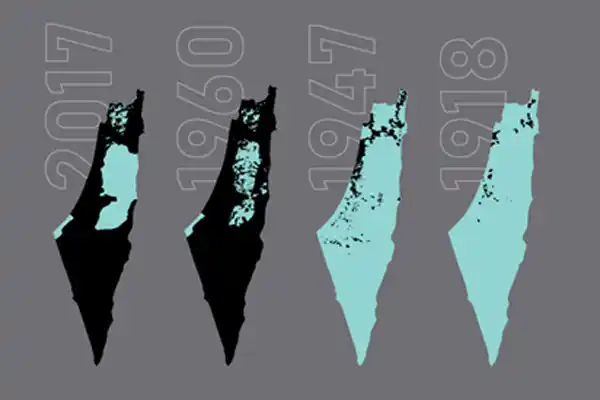
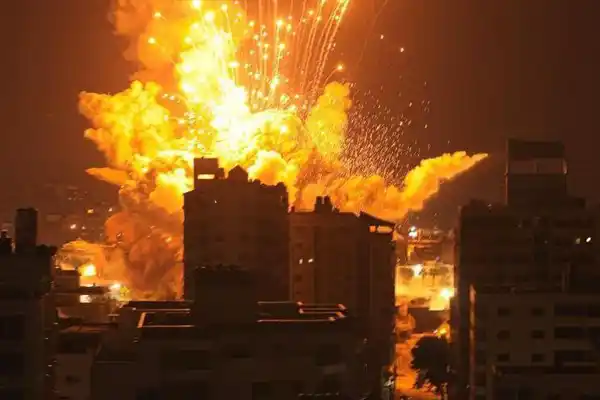
From 1947, the transfer and sale of lands under British control to Zionist organizations and the displacement of Palestinian residents accelerated, ultimately leading to Britain deciding to withdraw from Palestine in 1948 and handing the country over to the Israelis! Following the establishment of the State of Israel and the expulsion of over 750,000 Palestinians from their homes in 1948—an event known as the forced exodus called the “Nakba”—the Zionist regime enacted laws in 1960 to confiscate the majority of Palestinian lands. Additionally, since occupying the West Bank and Gaza in 1967, this government has unilaterally allocated tens of thousands of hectares of so-called “state land” to Israeli settlements by 2017.3 In this manner, throughout all these years, the territorial expanse of the Israeli regime has been expanding, while Palestine’s body has been shrinking and fragmented.
Jerusalem, a City for Everyone!
Another question surrounding the Palestinian issue is the status of Palestinians in its capital, Jerusalem. East Jerusalem was occupied by Zionists in 1967 and illegally annexed to the territorial domain of the Israeli regime. This regime has always prevented the growth of the Palestinian community in this city, such that the number of Palestinians in Jerusalem has not exceeded 40 percent of its total population. For example, in 2012, Palestinians made up only 37 percent (300,000 people) of Jerusalem’s population, with 62 percent being Israeli Jews (509,000 people) and 2 percent others (12,000 people). The population control that Israel has imposed on Palestinians in Jerusalem has been enabled through the regime’s apartheid policies and methods.3

- One of these methods is allowing Israeli settlers to illegally settle in the city. Today, over 200,000 Israelis have settled in East Jerusalem this way. Meanwhile, more than 14,500 Palestinians have been deprived of their residency rights in the city since 1967..
- Another apartheid method against Palestinians in Jerusalem is not registering birth certificates for Palestinian children, such that now over 10,000 Palestinians in the city lack identification..
- Another apartheid policy of the Israeli regime in Jerusalem is discrimination in allocating the city’s budget to residents; 93 percent of Jerusalem’s budget goes to Israeli taxpayers and Jewish neighborhoods, while only 7 percent goes to Palestinian taxpayers (who make up 37 percent of the city’s population) and their neighborhoods.
- Another apartheid method is the expropriation of Jerusalem’s lands and restrictions on Palestinian construction in the city. In East Jerusalem, 87 percent of the land is prohibited for Palestinian construction, with only 13 percent allocated to them. Additionally, 93 percent of building permits in Jerusalem go to Israelis, and Palestinians, despite facing a shortage of 43,000 homes, have only obtained 7 percent of building permits.4 All these apartheid methods provide backing for the Zionists’ claim that Jerusalem belongs to them—a claim expressed by Benjamin Netanyahu during the occupation of East Jerusalem: “Jerusalem has always been the capital of the Jewish people; not of any other people!”5
When Law Falls from the Top of the Wall!
One of the issues surrounding the occupation of Palestine that has received much attention in international legal forums is the construction of the continuous wall on the West Bank of Palestine by the Zionist regime. The construction of this continuous barrier was approved by the Israeli government’s cabinet in June 2002, a decision that sparked debate leading to the United Nations General Assembly. In July 2004, following a request from the UN General Assembly, the International Court of Justice (ICJ) issued its advisory legal opinion on the wall. This court, the primary judicial organ of the UN responsible for resolving legal disputes between countries and issuing advisory opinions on international legal conflicts, consists of 15 judges, with no country having more than one judge. At the time the continuous barrier case was being adjudicated in this court, the 15 judges were: Judge Buergenthal, Judge Kooijmans, Judge Al-Arabi, Judge Koroma, Judge Guillaume, Judge Shi, Judge Owada, Judge Parra-Aranguren, Judge Ranjeva, Judge Rezek, Judge Simma, Judge Al-Khasawneh, Judge Vereshchetin, Judge Tomka, and Judge Higgins.
In this case, all judges except Judge Buergenthal ruled that “the wall is illegal,” citing reasons such as human rights violations, the wall’s nature as territorial annexation, and its unjustifiability on security grounds. Additionally, these 14 judges ruled that “Israel must dismantle the wall,” “Israel must pay reparations to Palestinians,” and “the United Nations must take action.” Furthermore, the court ruled that “states are obligated to act against the wall,” which was the outcome of the votes of all judges except Judge Buergenthal and Judge Kooijmans. However, nearly 20 years after the International Court of Justice’s decision, the construction of the continuous wall continues!6
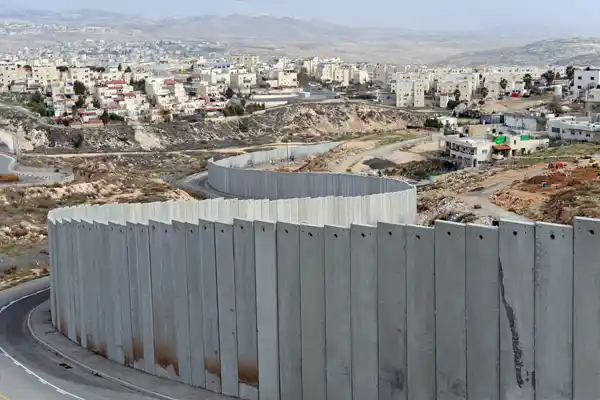
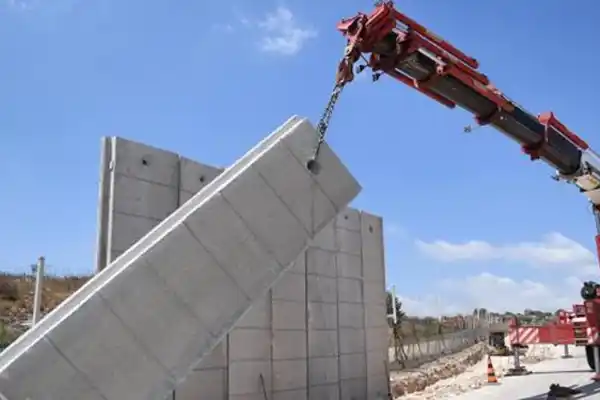
20 Years of Fruitless Negotiations
Despite numerous negotiations over the Palestinian issue spanning 20 years, this land still suffers from the presence of Zionists and their occupation of its soil. All the Oslo Accords (1993), Oslo II (1995), Camp David (2000), as well as the Taba talks (2001), Annapolis (2007), Washington (2010 and 2013) ended in failure, and Israeli settlement building and the displacement of Palestinians continue; such that the population of Israeli settlers has doubled and reached over 500,000 since 1993. Additionally, during this period, 11,000 Palestinians have been expelled from Jerusalem, 53,000 homes have been built for settlers—with an annual cost of $6.3 billion for the Israeli government on settlements since 2010—15,000 Palestinian homes have been destroyed, and 4,500 demolition orders have been issued for Palestinian homes. Moreover, the Zionist fragmentation and separation of Palestinians from one another is further evidence of the futility of negotiations; as 4.4 million Palestinians in Gaza and the West Bank have been separated in various ways, Gaza has been under blockade for 6 years, the West Bank has been divided into 167 isolated areas separated by 440 kilometers of walls and restricted by 522 checkpoints and barriers. Additionally, 4.8 million Palestinian refugees are still awaiting a solution.7

چه شد که پای سهیونیستها به خاک فلسطین باز شد؟
Resources
The Guardian, 2011. Timeline: Middle East Peace Talks
Foundation for Middle East Peace, 2012. Housing Stats in Israel, West Bank, and Gaza (2010-2011)
Peace Now, 2011. The Settlements: The Biggest Threat to a Two-State Solution
B'Tselem, 2013. Statistics on Settlements and Settler Population
Shir Hever in Newsweek, 2011. The Economics of Occupation
Internal Displacement Monitoring Centre, 2011. The State of Palestine
B'Tselem, 2013. Statistics on Destruction of Property
B'Tselem, 2013. Statistics on Revocation of Residency in East Jerusalem
UN OCHA, 2011. Humanitarian Factsheet on Area C of the West Bank
Palestinian Central Bureau of Statistics, 2013. Population Statistics
B'Tselem, 2013. Acting the Landlord: Israel's Policy in Area C, the West Bank
B'Tselem, 2013. Checkpoints, Physical Obstructions, and Forbidden Roads
B'Tselem, 2012. The Seperation Barrier - Statistics
B'Tselem, 2013. The Siege on Gaza







